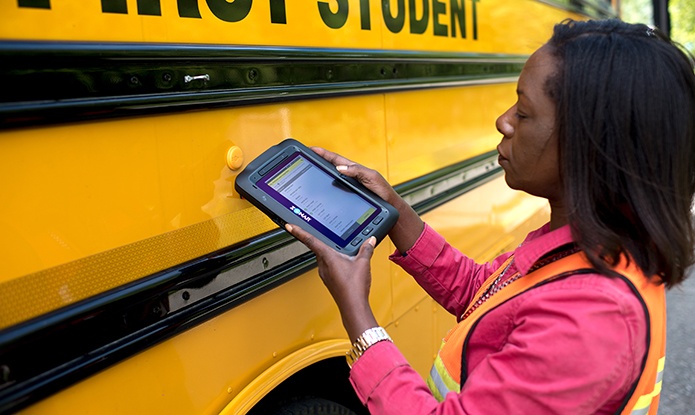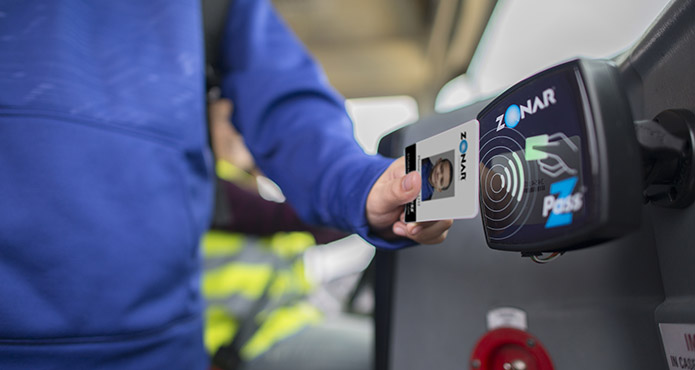
By H. Kevin Mest
Every year school buses transport over 23.5 million children to and from school while traveling over 4 billion miles According to the National Highway Traffic and Safety Administration, students are about 70 times more likely to get to school safely on a school bus rather than traveling by car. A lot goes into making the school bus safe – from the intelligent safety design and technology involved, to the transportation departments drivers and attendents who take the children to and from school. While transportation directors and drivers are committed to the safety of the children they transport, they are not always aware of the solutions that can be easily integrated into current processes to aid them in that mission. To better understand this, let us take a look at the day in the life of a school bus and how these safety technologies can be leveraged every day.
Pre-Trip Inspections and Trip Monitoring
It all starts in the bus yard. First, drivers need to complete a pre-trip inspection of the bus they will be driving to ensure that everything is in working order. Ideally, this inspection is conducted electronically and can be verified. This electronic verification ensures that all inspection zones on the bus are checked, there is a digital record of the inspection, and transportation directors know their drivers are doing the inspections properly every day. The inspection data can also be integrated into the bus shop’s maintenance software to help ensure that every bus is properly maintained and ready to go at the start of every day.
Once inspections are complete and the bus is ready from a safety, compliance, and operational perspective, students are likely making their way out to their respective bus stops. Transportation departments can leverage telematics boxes that are enabled with GPS, to track the school bus along its route and monitor any potential diagnostic issues with a bus. These devices come standard on the Thomas Built buses and are pre-wired for Blue Bird and International buses. In the event that an engine issue should happen, the transportation department can then determine if the bus can continue on its route safely or if immediate action is needed to send a replacement bus.

The Bus Stop
When the bus does arrive at a stop, and the stop arm deploys, many buses now leverage stop-arm camera safety programs. This. This automatically records video of vehicles that pass school buses illegally. Additionally, these programs issue the citation to the motorists with funds offsetting district’s entire school bus technology safety programs. But the benefits do not stop there. Drivers that receive violations rarely, if ever, repeat their mistake, making our roads and school bus stops safer than ever going forward.
After the stop-arm deploys and it is safe to board, students can swipe RFID cards with their ridership information. The swiping of these card records when and where the student boards the bus, which is then transmitted to the transportation department and the driver’s dashboard mounted tablet. This creates an electronic student roster to help ensure that the student is getting on the right bus at the right stop. This all happens in seconds, speeding the process to prevent the driver from having to manually carry a stack of paper rosters, allowing the bus to stay on-time with all stops along the route. This RFID card swipe process can also have additional benefits by helping in contact tracing should a child become ill.
Alerts Along the Route
On the drive to school, parents receive an alert letting them know that their student has boarded the bus. They can continue follow the bus with their app to know when their student arrives safely at school. This kind of visibility can be particularly helpful during inclement weather conditions, allowing children to stay indoors until their bus is near their stop.
While the driver is on the road, an onboard camera records any adverse driving events such as hard braking, speeding, stop sign violations, tailgating, hard cornering, hard accelerations, and lane drifting. Transportation directors and fleet managers can then use this information to coach their drivers to better and safer driving habits.
The Trip Back Home
After school, much of the same process takes place. Students navigate the sea of school buses but scan their RFID cards when boarding their bus. The driver uses the student data transferred to their tablet to verify that the student is on the right bus. A notification is sent to that student’s parent or caregiver letting them know that their child has boarded their scheduled bus home. Parents and caregivers can continue to track the bus to their child’s stop allowing them to best plan for pick-ups or have peace of mind that their child got home safely.
At each student’s afternoon stop, they again scan their RFID card when exiting the bus. The driver uses the information from the card to make sure that students are getting off the bus at the right stop. Parents also receive notifications on their phones alerting them that their student has gotten off the bus at their stop.
This exchange of custody of children is critical to safe school bus operations. Too often, students get off at the wrong stop, causing parents’ worry and panic about their child’s whereabouts. Instead, this can be easily avoided through the simple use of an RFID card.
Post-Trip Inspections
After the school bus driver completes their trip from dropping off students, they still need to do a post-trip inspection. A critical part of this process that is sometimes required but should always be followed as a best practice is ensuring that no child is left on the bus. By adding an alarm system or electronically verifiable check-in process to the back of the bus, transportation departments and school bus drivers can ensure that no student will accidentally get left on a bus, possibly in a bus yard. Tragically, this does occur and has led to legislation to help eliminate the events like California’s Paul Lee Law.
So why don’t more districts adopt these core technologies to ensure the safe transportation of students to and from school? Well, most have some technology onboard their buses but there is opportunity to obtain more to ensure safer rides for students and drivers. For example, there are stop-arm program incentives in particular states that cover the cost of technology adoption. There are also numerous grants available, including ones from NAPT and Zonar. Now, under the Biden administration, funds have been allocated to schools under the American Rescue Plan.
H. Kevin Mest is senior vice president of passenger services at Zonar. Visit www.zonarsystems.com for more information.


